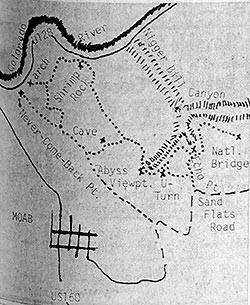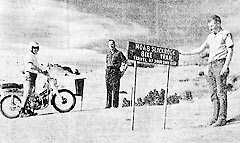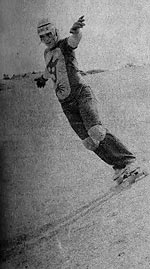CYCLING HAPPENINGS May 2020 |
||||||||
 Article courtesy of Rim Tours Mountain Bike Adventures 1233 S. Hwy 191, 435-259-5223 |
||||||||
The Little Known History Of Moab’s Slickrock Trail |
||||||||
Moab is known around the world as a mountain biking mecca, and much of that fame is due to The Slickrock Trail. “Slickrock” is arguably one of the most famous mountain bike trails in the world, with thousands of riders flocking each year to its steep and relatively smooth, rounded rollercoasters of sandstone fins and amazing views. In fact, for some, this famous trail is their personal mtb shangri la. Though, honestly, over the past 15 years, Moab has developed a ton of intermediate and advanced singletrack trails, some with almost as much slickrock surface, and which are far more rideable and fun. Rim Tours offers guided, all-inclusive day tours of all the area’s many wonderful mtb trails, if you’re of a mind to try them out.
The trail was originally created for motorcycles - specifically, the then new breed of ultra-lightweight Honda 90 trail bikes. The first mention of the Slickrock Trail in Moab’s local weekly newspaper of record, The Moab Times-Independent, is a March 27, 1969 article titled “Proposed New Slickrock Trail Would Provide Thrills for Trail Bikers,” by Dick Wilson. “The Slickrock Trail is a proposed route for trail-adapted motorcycles which provide access to a pure, unspoiled wilderness seldom visited presently, and even though it is within two to four miles from Moab, many of it’s features are not well known.” At this date, Moab was still in the throes of its uranium boom, and tourism was only a minor side note.
In the same issue, a sidebar article detailed safety recommendations by the county that includes strongly recommend “solo” riding (one person to a machine), discouraging people making the trip alone, discouraging contests, and riding close to the edge of cliffs.
Skateboarders Discover Slickrock An article in 1978 notes that “Moab has already become a haven for backpacking, fishing, 4-wheeling, motorcycling, and rafting” (note the absence of any mention of cycling) and proclaims the next sport to find Moab “may well be skateboarding.” A group of local skateboarders (David Urbanek, Joe Arnold, Ricky Berry and Charlie Gonzales) had started riding The Slickrock Trail a few years before, and were featured in “The Wide World of Skateboarding.” Afterward, the paper mentions that “skaters started calling,” especially from neighboring Grand Junction, CO. It would be years before mountain bikers began riding Slickrock Trail, or Moab gained its first mountain bike store, Rim Cyclery, which opened in 1983. This was the year after Moab’s uranium processing plant closed, signally the end of an era and the beginning of a new one. Soon after, Moab started making the news as the Mountain Bike Capital of the World, largely due to media coverage as The Slickrock Trail was adopted by its third principal sport, mountain biking.
|



